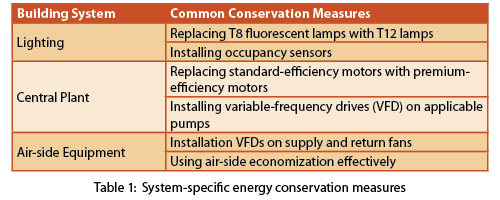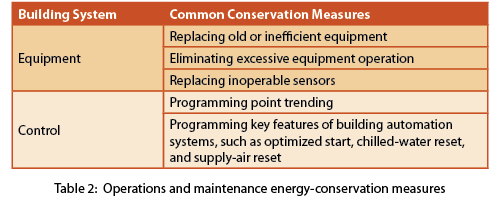Components to Consider When Identifying Energy Waste
Managers looking to take a more hands-on approach to identifying energy waste in facility systems can consider a walk-through energy assessment. The approach has three components:
Understanding the building and building systems. Performing a walk-through survey gives managers and technicians a better understanding of the building's construction, equipment, and energy-using systems. During walk-throughs, managers and technicians can identify opportunities for equipment upgrades, as well as system modifications that might improve overall system performance.
Two examples of equipment upgrades are replacing existing motors with premium-efficiency motors and installing variable-frequency drives (VFD) to control cooling-tower motors. It also is important to identify these major energy-consuming systems and define the different functions within the building. Important questions to ask during the walk-through assessment relate to systems already in place, and steps technicians can take to improve their efficiency. Table 1 below provides general conservation measures commonly identified during a walk-through assessment.
Understanding operations and maintenance practices. One essential element of energy assessments is having discussions with engineering and operations technicians regarding the operation and maintenance of a building's energy-consuming systems. These technicians handle the equipment every day and are familiar with the building systems. They can identify maintenance problems and propose changes to operations and maintenance practices that improve energy efficiency.
Reviewing building automation systems (BAS) can help managers further understand operation of the major energy-consuming system. This step is important because a large portion of the effort to optimize the operation of the building systems relates directly to how the building is conditioned and controlled.
Technicians also can use the BAS to test the operation of building systems in order to identify problematic energy-saving measures, such as faulty sensors or controllers, improper operation, and systems that have failed or are failing. Table 2 below provides general conservation measures commonly identified during a review of operation and maintenance practices.
Analyzing a building's energy use. Benchmarking is a key step in evaluating energy efficiency. It gives managers a benchmark, and it provides hard data to take to top facility executives to build support for improvements.
One good place to start is with a review of the utility bills. The more utility bills managers can review the better. It is important to use these bills to understand the building's current energy consumption and, if possible, the trend of past energy use. Knowing where a facility was in terms of energy use, as well as where it is now, can help managers set goals for future performance. This step is important when engaging top executives and can give managers hard data to build support for energy-conservation measures.


Related Topics:
















